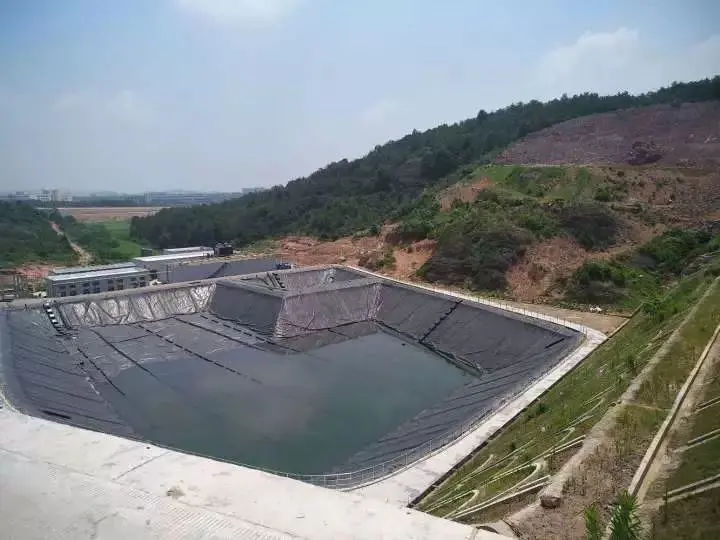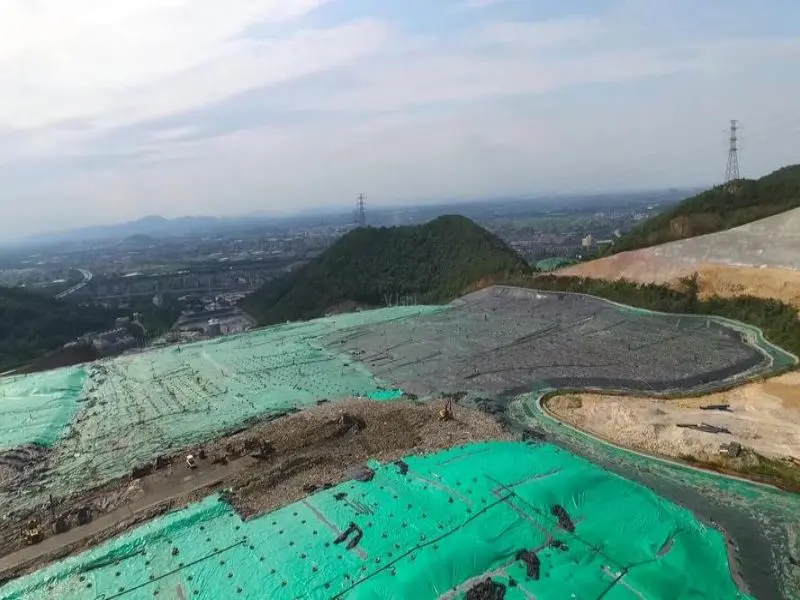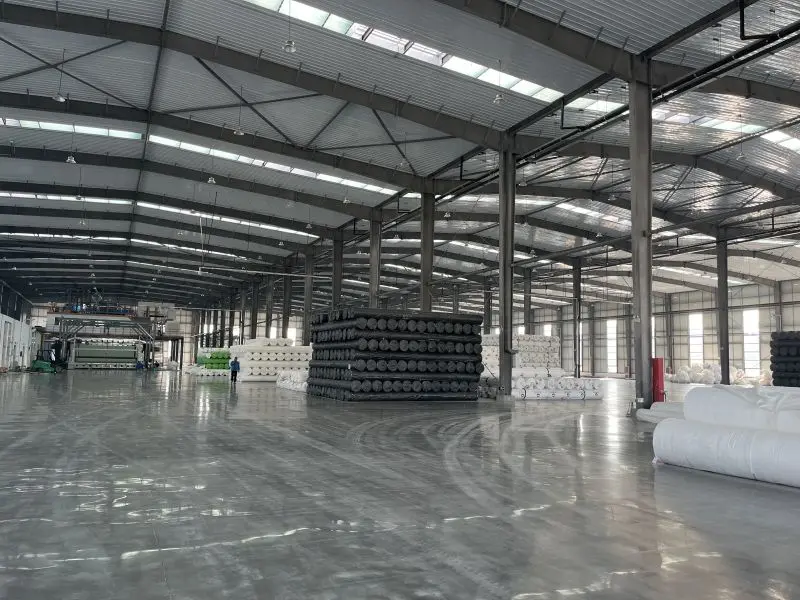Geomembranes: Characteristics and Applications
Geomembranes are impermeable membranes used primarily for containment and barrier applications. They are typically made from synthetic polymers such as high-density polyethylene (HDPE), linear low-density polyethylene (LLDPE), and polyvinyl chloride (PVC). The primary function of geomembranes is to act as a barrier to prevent the migration of fluids (liquids or gases) from one area to another.
Key Characteristics:
Impermeability: Geomembranes are designed to be highly impermeable, with water vapor transmission rates as low as 0.5 grams per square meter per day.
Chemical Resistance: They exhibit excellent resistance to a wide range of chemicals, making them suitable for hazardous waste containment.
Durability: Geomembranes have a long lifespan, with some products designed to last over 50 years under certain conditions.
Applications:
Landfill Liners: Geomembranes are extensively used in landfill liners to prevent leachate from contaminating groundwater.
Mining: Used in heap leach pads to contain and recover precious metals.
Water Containment: Employed in reservoirs, ponds, and canals to prevent water loss.
Secondary Containment: Used in industrial settings to contain spills and leaks of hazardous materials.

Geotextiles: Characteristics and Applications
Geotextiles are permeable fabrics used in various civil engineering applications for separation, filtration, reinforcement, protection, and drainage. They are generally made from polypropylene or polyester and come in two main types: woven and non-woven geotextiles.
Key Characteristics:
Permeability: Unlike geomembranes, geotextiles are designed to allow water to pass through while retaining soil particles, making them ideal for filtration applications.
Tensile Strength: Woven geotextiles offer high tensile strength, which is crucial for reinforcement applications.
Flexibility: Geotextiles are flexible and can conform to irregular surfaces, which is beneficial in various construction scenarios.
Applications:
Road Construction: Used to separate and stabilize soil layers, preventing the intermixing of subgrade and aggregate layers.
Erosion Control: Installed on slopes and riverbanks to prevent soil erosion while allowing water to drain.
Drainage Systems: Used in subsurface drainage systems to filter soil particles and enhance water flow.
Landscaping: Employed as weed barriers and soil stabilization layers in gardening and landscaping projects.
671657.webp)
Comparative Analysis
Functionality:
Containment vs. Filtration: Geomembranes are primarily used for their containment capabilities, ensuring no fluid migration, while geotextiles are used for their filtration and drainage properties.
Impermeability vs. Permeability: Geomembranes are impermeable, making them suitable for applications requiring a complete barrier. Geotextiles, on the other hand, are permeable, allowing water to pass through while retaining soil particles.
Material Properties:
Strength: Geomembranes generally exhibit higher tensile strength and puncture resistance compared to geotextiles. For example, an HDPE geomembrane can have a tensile strength of up to 30 MPa, whereas a typical woven geotextile may have a tensile strength around 20 kN/m.
Chemical Resistance: Geomembranes offer superior chemical resistance, making them ideal for applications involving hazardous substances. Geotextiles, while also chemically resistant, are more prone to degradation in highly aggressive environments.
Durability and Lifespan:
Geomembranes: With proper installation and maintenance, geomembranes can last over 50 years. For instance, HDPE geomembranes used in landfill liners have been documented to maintain their integrity for several decades.
Geotextiles: The lifespan of geotextiles varies depending on the application and environmental conditions, typically ranging from 10 to 20 years. Non-woven geotextiles used in road construction have been observed to maintain functionality for up to 20 years.
Cost Considerations:
Geomembranes: Generally more expensive due to their material properties and manufacturing process. The cost of HDPE geomembrane ranges from $2 to $3 per square meter.
Geotextiles: Typically more cost-effective, with non-woven geotextiles priced around $1 to $2 per square meter, making them a more economical choice for large-scale applications requiring filtration and separation.
Both geomembranes and geotextiles are indispensable in modern civil engineering and environmental management. While geomembranes provide unparalleled containment capabilities, geotextiles excel in filtration, drainage, and soil stabilization. Understanding the distinct properties and applications of these materials enables engineers and project managers to select the appropriate geosynthetic for their specific needs, ensuring optimal performance and longevity of their projects.

Geomembrane vs. Geotextile: Pros and Cons
When choosing between geomembranes and geotextiles for various engineering and environmental projects, it's essential to understand their respective advantages and disadvantages. This comparison will help in making informed decisions based on the specific requirements of each application.
Geomembranes
Pros:
Impermeability:
Geomembranes provide an effective barrier against fluids, preventing the migration of liquids and gases. This makes them ideal for containment applications such as landfill liners and pond liners.
Chemical Resistance:
They offer excellent resistance to a wide range of chemicals, including acids, bases, and solvents, making them suitable for hazardous waste containment.
Durability:
Geomembranes have a long lifespan, often exceeding 50 years when properly installed and maintained. They are resistant to environmental degradation, UV radiation, and biological attack.
High Tensile Strength:
Materials like HDPE geomembranes have high tensile strength, which allows them to withstand significant stresses and strains without rupturing.
Cons:
Cost:
Geomembranes are generally more expensive than geotextiles, with costs ranging from $2 to $3 per square meter, which can increase the overall project budget.
Installation Complexity:
Installation of geomembranes can be complex and requires specialized equipment and skilled labor to ensure proper seams and prevent leaks.
Limited Flexibility:
They are less flexible compared to geotextiles, making them challenging to install on uneven or irregular surfaces.
Potential for Punctures:
Despite their strength, geomembranes can be punctured by sharp objects or heavy loads, requiring careful handling and additional protective layers.
Geotextiles
Pros:
Permeability:
Geotextiles are designed to allow water to pass through while retaining soil particles, making them ideal for filtration and drainage applications.
Cost-Effective:
They are generally more affordable than geomembranes, with prices typically ranging from $1 to $2 per square meter, making them economical for large-scale projects.
Ease of Installation:
Geotextiles are lightweight and flexible, making them easy to handle and install, even on irregular surfaces.
Versatility:
They can be used for various functions, including separation, filtration, reinforcement, and erosion control.
Cons:
Lower Tensile Strength:
Compared to geomembranes, geotextiles have lower tensile strength, which may limit their use in applications requiring high strength and durability.
Limited Chemical Resistance:
While geotextiles are resistant to many chemicals, they may degrade faster in highly aggressive environments compared to geomembranes.
Shorter Lifespan:
The lifespan of geotextiles is typically shorter, ranging from 10 to 20 years, depending on the application and environmental conditions.
Potential Clogging:
In filtration applications, geotextiles can become clogged with fine particles over time, reducing their effectiveness in draining water.
Both geomembranes and geotextiles offer distinct advantages and disadvantages, making them suitable for different applications. Geomembranes excel in containment and barrier applications due to their impermeability and chemical resistance, while geotextiles are preferred for filtration, drainage, and soil stabilization due to their permeability and cost-effectiveness.
When selecting between these two materials, it's crucial to consider the specific requirements of the project, including the desired lifespan, environmental conditions, and budget constraints. By understanding the pros and cons of geomembranes and geotextiles, engineers and project managers can make informed decisions that optimize performance and cost-efficiency.
863519.webp)
Geomembrane vs. Geotextile: Real-World Engineering Examples and Selection Criteria
Choosing between geomembranes and geotextiles in real-world engineering projects involves a thorough understanding of their properties and the specific needs of the project. Here are several examples illustrating how to choose between these materials based on different engineering scenarios:
Example 1: Landfill Liner System
Project Requirements:
Containment of hazardous waste: The primary concern is preventing leachate from contaminating groundwater.
Durability: The liner must last for decades without significant degradation.
Chemical resistance: The material must withstand a variety of chemicals present in the waste.
Material Choice: Geomembrane
Reasoning: Geomembranes, particularly HDPE, are highly impermeable, chemically resistant, and durable. They can effectively contain hazardous waste and prevent leachate migration for extended periods, making them ideal for landfill liners.
Example 2: Road Construction
Project Requirements:
Soil stabilization: Preventing the mixing of subgrade and aggregate layers.
Drainage: Ensuring proper water flow to avoid waterlogging and road damage.
Cost-effectiveness: The project requires a large area to be covered economically.
Material Choice: Geotextile
Reasoning: Geotextiles are permeable, allowing water to pass through while maintaining soil separation. Their cost-effectiveness and ease of installation make them suitable for large-scale road construction projects where soil stabilization and drainage are critical.
Example 3: Erosion Control on a Slope
Project Requirements:
Erosion prevention: Stabilizing the soil to prevent erosion.
Vegetation support: Allowing plants to grow and further stabilize the soil.
Flexibility: The material must conform to the slope's contours.
Material Choice: Geotextile
Reasoning: Non-woven geotextiles are ideal for erosion control as they allow water to drain while providing soil stabilization. Their flexibility allows them to conform to the slope, and they can support vegetation growth, further enhancing erosion control.
Example 4: Water Containment in a Pond
Project Requirements:
Water impermeability: Preventing water loss through the pond's base and sides.
Durability: The liner must withstand exposure to sunlight, water pressure, and possible mechanical damage from aquatic life.
Environmental safety: Ensuring the liner material does not leach harmful chemicals into the water.
Material Choice: Geomembrane
Reasoning: Geomembranes, especially those made from materials like HDPE or PVC, are highly impermeable and durable. They can effectively contain water without leaking and are resistant to UV radiation and mechanical damage, making them suitable for pond liners.
Example 5: Subsurface Drainage System
Project Requirements:
Water filtration: Allowing water to pass through while filtering out soil particles.
Durability: Withstanding the weight of the overlying soil and traffic loads.
Easy installation: Simple and quick installation process.
Material Choice: Geotextile
Reasoning: Geotextiles are designed for filtration and drainage applications. They allow water to pass through while preventing soil particles from clogging the drainage system. Their durability and ease of installation make them ideal for subsurface drainage systems.
When selecting between geomembranes and geotextiles for an engineering project, the decision hinges on the specific requirements of the application. Geomembranes are the go-to choice for applications requiring impermeable barriers and chemical resistance, such as landfill liners and water containment. On the other hand, geotextiles are preferred for applications involving filtration, drainage, and soil stabilization, like road construction and erosion control.
By carefully evaluating the project needs and understanding the properties of these materials, engineers can make informed choices that optimize performance, durability, and cost-effectiveness.
Geomembrane vs. Geotextile Manufacturing Standards
The manufacturing of geomembranes and geotextiles is governed by various international standards that ensure quality, performance, and suitability for specific applications. These standards provide guidelines for material properties, testing methods, and performance criteria. Here is an overview of key manufacturing standards for geomembranes and geotextiles.
Geomembrane Manufacturing Standards
ASTM D4437
Title: Standard Practice for Determining the Integrity of Field Seams Used in Joining Flexible Polymeric Sheet Geomembranes
Description: Specifies procedures for testing the integrity of field seams in geomembrane installations.
ASTM D7466
Title: Standard Practice for Handling, Transportation, and Storage of Geomembranes
Description: Provides guidelines for the proper handling, transportation, and storage of geomembrane materials to prevent damage and ensure quality.
ASTM D6693
Title: Standard Test Method for Determining Tensile Properties of Nonreinforced Polyethylene and Nonreinforced Flexible Polypropylene Geomembranes
Description: Specifies test methods for measuring the tensile properties of polyethylene and polypropylene geomembranes.
ISO 10318-1
Title: Geosynthetics - Part 1: Terms and Definitions
Description: Defines the terminology used in geomembrane manufacturing and testing.
ISO 1183
Title: Plastics - Methods for Determining the Density of Non-Cellular Plastics
Description: Provides methods for determining the density of geomembrane materials.
Geotextile Manufacturing Standards
ASTM D4354
Title: Standard Practice for Sampling of Geosynthetics and Rolled Erosion Control Products (RECPs) for Testing
Description: Provides procedures for obtaining representative samples of geotextiles for testing purposes.
ASTM D4595
Title: Standard Test Method for Tensile Properties of Geotextiles by the Wide-Width Strip Method
Description: Specifies methods for testing the tensile properties of geotextiles using the wide-width strip method.
ISO 10319
Title: Geosynthetics - Wide-Width Tensile Test
Description: Specifies methods for determining the tensile strength and elongation of geotextiles.
ISO 11058
Title: Geotextiles and Geotextile-Related Products - Determination of Water Permeability Characteristics Normal to the Plane, Without Load
Description: Provides test methods for determining the water permeability of geotextiles.
EN 13249
Title: Geotextiles and Geotextile-Related Products - Characteristics Required for Use in the Construction of Roads and Other Trafficked Areas (Excluding Railways and Asphalt Inclusion)
Description: Specifies the characteristics of geotextiles used in road construction and other trafficked areas.
Comparison of Standards
Material Properties:
Geomembranes: Standards focus on impermeability, tensile strength, and chemical resistance.
Geotextiles: Standards emphasize permeability, filtration efficiency, and tensile strength.
Testing Methods:
Geomembranes: Include methods for testing seam integrity, tensile properties, and environmental resistance.
Geotextiles: Include methods for testing tensile strength, water permeability, and filtration properties.
Application-Specific Standards:
Geomembranes: Standards are often application-specific, such as those for landfill liners or water containment.
Geotextiles: Standards cover a wide range of applications, including road construction, erosion control, and drainage systems.
Manufacturing standards for geomembranes and geotextiles ensure that these materials meet the necessary quality and performance criteria for their intended applications. By adhering to these standards, manufacturers can produce reliable and effective products that fulfill the requirements of civil engineering and environmental projects.
Understanding these standards helps engineers and project managers select the right materials for their projects, ensuring optimal performance and durability.
Introduction to Haoyang Environmental
Haoyang Environmental is a leading manufacturer and supplier of geomembranes and geotextiles based in China. With a robust manufacturing facility, Haoyang Environmental stands out in the industry due to its commitment to quality, innovation, and customer satisfaction.

State-of-the-Art Manufacturing Facility
Haoyang Environmental operates a state-of-the-art factory equipped with advanced production lines and modern machinery. The factory spans over 10,000 square meters, allowing for large-scale production without compromising on quality. Our facility is ISO 9001 certified, ensuring that every product meets stringent international standards.
Superior Quality Control
Quality is at the forefront of Haoyang Environmental’s manufacturing process. We employ a rigorous quality control system that includes multiple stages of testing and inspection. Each product undergoes thorough testing for durability, tensile strength, chemical resistance, and permeability. This meticulous approach guarantees that our geomembranes and geotextiles perform exceptionally well in diverse applications such as landfill liners, road construction, and erosion control.
Experienced Team
Our factory is staffed by a team of highly skilled engineers and technicians with years of experience in the geosynthetics industry. Their expertise allows us to innovate continuously and improve our product offerings. We invest heavily in training and development to ensure that our team remains at the cutting edge of industry advancements.
Customization and Flexibility
At Haoyang Environmental, we understand that different projects have unique requirements. That’s why we offer customized solutions tailored to meet specific project needs. Whether it’s a particular size, material composition, or performance characteristic, our team works closely with clients to deliver products that align perfectly with their requirements.
Sustainability Commitment
We are dedicated to sustainable manufacturing practices. Our production processes are designed to minimize environmental impact, and we use eco-friendly materials wherever possible. Haoyang Environmental is committed to contributing to a greener future while providing high-quality geosynthetics.
Global Reach
With a solid reputation in the global market, Haoyang Environmental supplies geomembranes and geotextiles to over 50 countries worldwide. Our products have been widely acclaimed for their reliability and performance, earning us a loyal customer base across various industries.
Choose Haoyang Environmental for your geomembrane and geotextile needs and experience the advantages of working with a top-tier manufacturer dedicated to quality, innovation, and customer satisfaction.
![]() Geotextiles and Geomembranes in Civil Engineering.pdf
Geotextiles and Geomembranes in Civil Engineering.pdf
794.webp)
897.webp)
942.webp)
237.webp)